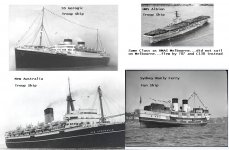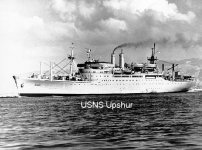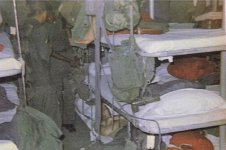The RFA Sir Bedivere. Used to fly most everywhere - usually in a Hercules - and arrive deafened!
I sailed on this one several times for exercises in Europe, when we took our vehicles with us. Because these are really large landing craft vessels - they have a flat bottom and roll about in rough weather. I remember being sat in my 3 tonner (chained down to the top deck) and watching her sister ship Sir Gallahad - sailing alongside roll towards us as we rolled towards her. For a moment, I looked down her funnel and saw the glow of her boiler burning. That's when I realised we had rolled 45 degrees towards her - and she had rolled 45 degrees towards us!! That was a strange feeling.
I was sat in my truck - because there was fresh air up on top. Down below - where we all bunked - it was pretty grim. The food on board was excellent though - and I remember that all the cooks were of Chinese origin. Couldn't understand a word they said - but excellent cooks. usually plenty of it too - as many couldn't eat any food , once we got into the North Sea. Thankfully, that never bothered me when I was a young lad - I'd eat anything, anywhere and anytime! As a Radio-operator - we were used to dashing about - and often ate whenever and wherever we could.
I found out recently that both ships had been de-commissioned by the UK - and sold on to the Brazilian Navy. Here she is. jb

 Idling time away on the magic of Google image I thought I wonder if I could find picture's of the ships I have traveled on.... sure enough..there they were......did not worry about canoes,rubber ducke's or tinies.....it suddenly dawned on me...I have probably spent more time at sea than some sailors....I think I will apply for my water wings...TomB
Idling time away on the magic of Google image I thought I wonder if I could find picture's of the ships I have traveled on.... sure enough..there they were......did not worry about canoes,rubber ducke's or tinies.....it suddenly dawned on me...I have probably spent more time at sea than some sailors....I think I will apply for my water wings...TomB



